My least favorite section in the New York Times Magazine is the insipid “Who Made That?” column. In theory, it’s a great idea for a regular feature. We’re surrounded by gadgets and inventions with rich histories that we never think about. But in practice, the column always dwells on trivial inventions (“Who Made That Loofah Mitt? Sippy Cup? Kickstand?”) and ones with boring stories at that (or, at least, they are stories boringly told). Most of the time, the story is, “some guy thought this was a good idea, then sold it out of his basement for awhile, and then it became successful, and now it is ubiquitous.” Snore.1
There are a number of things wrong with this approach. One is that it reinforces a notion of the “lone inventor” that wasn’t even very accurate by the late-19th century. Most American inventions (as measured by patents, for example) are generated in collaborative groups by corporations.2 The idea that invention, even American invention, is a product of quirky kooks is a romantic myth. Another issue is that it generally sees all of these as “solitary” instances of invention — rather than the more common cases of incremental development, cross-pollination, and so on. And yet another issue is that most inventions (again, measured by patents or whatever else you want to use as a proxy) are abject failures. That is, almost no patents end up turning a profit, almost no inventions end up being very successful. The Times column generally makes it sound like all one needs is a good idea, and it’ll take off on its own. But the reality is much more weird and idiosyncratic than that. The columns end up being fluffy and trivial without being interesting, which to me is a cardinal sin. I mean, if you need to do something fluffy and trivial to get by, I understand that. But don’t be boring about it.
The one good thing about “Who Made That?” is that usually it doesn’t focus in on the few “canonical” inventions that everybody likes to talk about. There is some real value in getting away from the standard stories, as usual. We’ve heard so much about the invention of the atomic bomb. But when was the last time you heard about the invention of the firebomb? Obviously this is because one of these is a technological marvel, improbably created in an impressively short amount of time. I’m not knocking the bomb as the more interesting invention case. But the firebombs are impressive in their own way — and in a very deep sense, the story of their invention is the more shocking one, if only for its banality.
The atomic bomb represents, in a sense, a case of a special almost-one-off invention meant to be something novel and terrible. The firebomb, by contrast, is a weapon developed for a doing terrible things as a regular mode of operation. That is, the moral arguments in favor of the atomic bombs are usually structured in the form of “we had to do this twice in order to achieve a greater good.” It’s harder to do that with firebombs because we used them so many times. It’s one thing to say, “ah, once or twice we had to target large numbers of civilians to make a point.” It’s another to make the targeting of civilians your everyday job, when you start measuring success less by knocking out specific military targets and instead by total area destroyed. So who made that firebomb? A now all-too-familiar mixture of American industry, universities, and government. The list of contractors involved in American incendiary weapons during World War II includes Brown University, University of Chicago, Du Pont, Eastman Kodak, Harvard University, Monsanto, Standard Oil Development, and Stanford University, among others, all working under the auspices of Vannevar Bush’s Office of Scientific Research and Development, the Chemical Warfare Service, and other parts of the military.
The incendiary raids against Japan dropped numerous types of bombs in different combinations. But the one to focus on, because of its ubiquity and importance in the Pacific theatre, is the AN-M69 Incendiary Bomb. This was a cluster-based napalm weapon created by the Standard Oil Development Company, specifically designed to destroy Japanese civilian houses. The most common cluster assembly (the M19) held 38 individual AN-M69s and would release them 5,000 feet above the target. The wind would catch their parachute streams, moving them apart from one another and orienting them nose-down. (Doing this would also arm the bombs by pulling out their safety plungers.) After impact, the bombs would wait 3 to 5 seconds, seemingly inactive. This is to make sure each one is lying on its side, so that, finally, a stream of burning napalm would be explosively blasted out of the tail: “If unobstructed, the burning fuel charge will travel up to 300 ft horizontally, and when it strikes a surface, the flaming fuel charge smears out producing a mass of flames 6 to 10 ft high.”
Each B-29 could carry 40 clusters in their bomb bays. So that’s 1,520 AN-M69s per plane, and the raids could range from dozens to hundreds of planes. You can do the math, there. Over 40,000 tons of AN-M69s were dropped on Japanese cities during the war. It took about 125 tons per square mile to completely burn out an area of a Japanese city. The AN-M69 had, a once-classified postwar report announced triumphantly, “the highest fire-starting efficiency per cluster, or per ton, or per bomber of any incendiary bomb” developed during the war.3
The AN-M69 wasn’t the only incendiary bomb. I want to give a quick shout-out also to the E19 Incendiary Bomb, an 11 pound incendiary developed by my alma mater, Harvard University, as a combination of magnesium, oil, thermite, and white phosphorous. It didn’t burn as well as the AN-M69, but had greater penetrating power. But, as the aforementioned report notes, “this factor diminished in importance as the war went on,” presumably because we had stopped trying to directly target troublesome factories and military bases, and had instead moved on to targeting flimsy civilian structures. As a result, “the E19 bomb was never seriously considered for production.” But don’t worry Harvard, you still get some credit in the development of napalm (jellied gasoline) itself, as part of coordinated work with Eastman Kodak and Standard Oil Development. Some 80 million pounds of napalm were produced and used during the war.
Standard Oil Development’s creation of the AN-M69 started in early October 1941 — almost exactly two months before the attack on Pearl Harbor. The initial instigation was to find a way to make incendiary weapons that did not involve large amounts of magnesium, which was in short supply. The work was funded by the Office of Scientific Research and Development. Much of the technical details (horizontal fuse, hexagonal assembly, etc.) are probably mildly interesting to engineers but for the rest of us are probably just of interest in that they are a banal, everyday description of how to develop an efficient weapon for burning lots of things (and people) up.
The ballistic properties, cluster dispersal patterns, failure rates, and the ability to set various types of target ablaze were, of course, meticulously tested. Reading the developmental history of the firebomb, one finds the names of no individual inventors, only the organizations involved. It is not a history of brilliance or ingenuity, though no doubt there were lots of little brilliant insights along the way. It is, rather, an engineering job. What makes it disturbing is that the engineering is very explicitly directed towards the destruction of civilian life. The main structures they were tested on were mock “German houses” and mock “Japanese houses.” Not factories — houses. 37% of all “German houses” the AN-M69 were tested on were “beyond fire-guard control” within 6 minutes. For the more simple Japanese houses, it was 68%. The results of this testing, the report informs, “were used to make preliminary estimates of the quantities of incendiary bombs required to destroy Japanese cities.”
The effects testing, done very carefully by both universities (Harvard again, along with the University of Chicago), corporations (Standard Oil Development, Texas Company), and the military (Ordnance Department) are also pretty grim. These involved mock bedrooms, with beds and boudoirs and even vanity mirrors, to simulate how effect these weapons would be against “Central German structures,” “experimental Japanese rooms,” and other models of homes. Just in case there was any lingering doubt as to what these weapons were meant to accomplish, and to put to rest the lingering misconception that the destruction of civilian life was an inadvertent consequence imprecise weaponry.
Some 4,400 tons of AN-M69s were dropped on Tokyo during two May 1945 bombing raids, destroying 22.1 square miles. The famous March 1945 raid destroyed 12.5 square miles with only 279 B-29 bombers.4 The area of the Hiroshima bombing where domestic houses were severely damaged was only 8.5 square miles, by comparison.
I don’t want to sound naive about these things. Obviously, World War II was a state of “total war” by all sides, and very little was considered off-limits. But I still feel that too many Americans today don’t take into account exactly what was done in the name of total victory — we still view World War II as the “good war” of the “Greatest Generation.” Purposeful mass burning of civilians doesn’t usually come into it. At the end of the day, I don’t think I really believe in “good wars” — there are wars of necessity, and there are wars of “greater good/necessary evil.” I don’t think you get any better than that, unfortunately.

Hypertrophic scars and keloids on a napalm-bombed child. I don’t know who this is of, or even when it was taken — I suspect it is from the Vietnam War. It is from SIPRI’s Incendiary Weapons (1975), chapter 3, “Thermal effects of incendiary weapons on the human body,” without a source listed. It puts a “human face” on these weapons, though, like no other photograph I’ve seen. There is something about the beauty of the unscarred eye that makes the damage so palpable.
During the war, the inventive forces of the United States went to work to find creative engineering solutions to the problem of burning millions of civilians alive. I really don’t want to use the phrase “banality of evil,” since it has been so over-applied, and I don’t really believe in “evil” as a useful historical concept, but there is certainly a terrible banality at work here when one reads about the work that went into crafting these unassuming little bombs. They are so less flashy, as inventions, than the atomic bomb, of course. But that doesn’t make them any less worth our attention. Arguably, it is their “normal-ness” and their easy assimilation into regular military doctrine that makes them more important for us. The more interesting moral questions don’t involve what one would do in exceptional situations, but one does in the every-day.
- For an example of how to do something of this right, take a look at the discussion of the Victorian teapot in Neil MacGregor’s A History of the World in 100 Objects. MacGregor manages to take something supposedly mundane — a simple teapot — and use it as a fascinating window into the history of imperialism and globalization. [↩]
- See, e.g., David F. Noble, America by Design: Science, Technology, and the Rise of Corporate Capitalism (1977). [↩]
- Almost all of my information here comes from “Fire Warfare: Incendiaries and Flame Throwers,” Summary Technical Report of Division 11, National Defense Research Committee, Volume 3 (Washington, DC, 1946). It was originally classified as “confidential.” There is a scanned copy online, along with many other reports on the subject, at the extremely useful website, Japan Air Raids (japanairraids.org). The images of the bombs and tests come from other reports on that page. [↩]
- The May 1945 raids had significant number of other types of incendiary bombs as well, though the AN-M69s were the overwhelming majority. The March 1945 raids were almost exclusively AN-M69s. [↩]
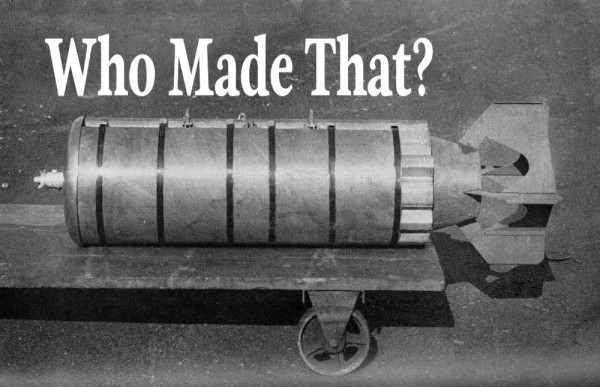
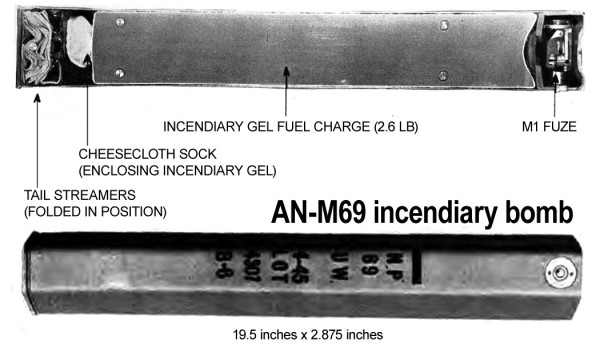
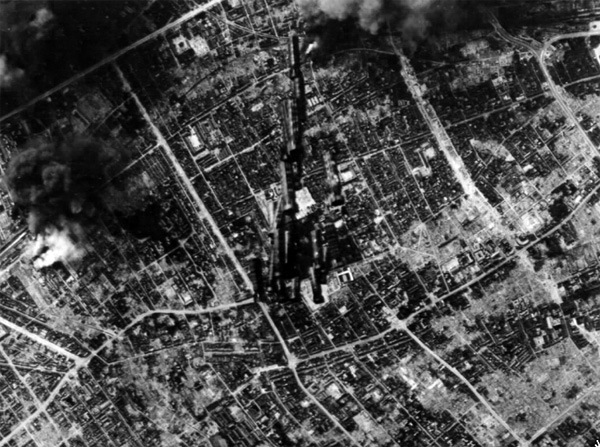
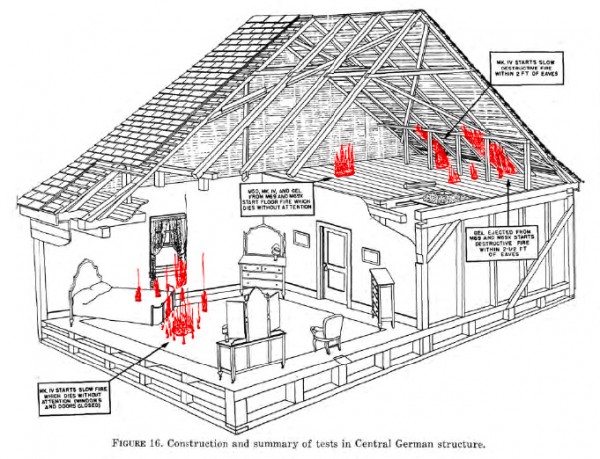
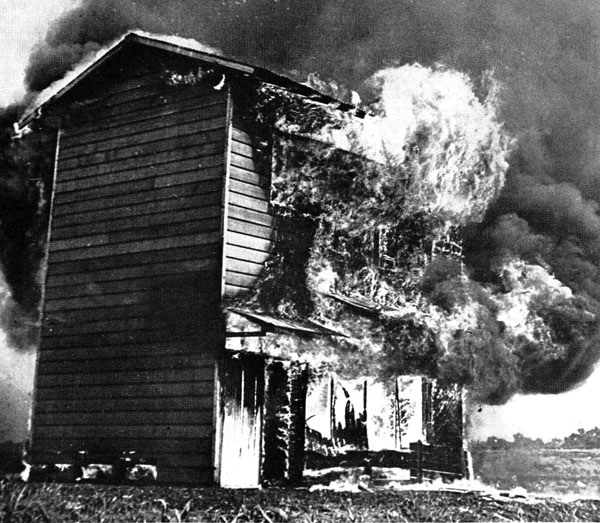



The British were just as keen on incendiary bombs. Here’s the relevant section from the Wikpedia entry on the weapons. ICI stands for Imperial Chemical Industries, the British equivalent of DuPont.
The 4 lb (1.8 kg) incendiary bomb, developed by ICI, was the standard light incendiary bomb used by RAF Bomber Command in very large numbers, declining slightly in 1944 to 35.8 million bombs produced (the decline being due to more bombs arriving from the USA). It was the weapon of choice for the British dehousing plan. The bomb consisted of a hollow body made from aluminium-magnesium alloy with a cast iron/steel nose, and filled with thermite incendiary pellets. It was capable of burning for up to ten minutes. There was also a high explosive version and delayed high explosive versions (2–4 minutes) which were specifically designed to kill rescuers and firefighters. Other tactics consisted of using explosive bombs in the attack to fill the streets with craters and rubble, hindering rescue services.
Towards the end of World War Two, the British introduced a much improved 30 lb (14 kg) incendiary bomb, whose fall was retarded by a small parachute and on impact sent out an extremely hot flame for 15 ft (4.6 m); it burned for approximately two minutes. Articles in late 1944 claimed that the flame was so hot it could crumble a brick wall. And for propaganda purposes the RAF dubbed the new incendiary bomb the Superflamer. Very little else is known about this new incendiary bomb that came into operational service late in the war in the European theater.[4] Around fifty-five million incendiary bombs were dropped on Germany by Avro Lancasters alone.
I’d never seen the word “Dehousing” before. I see it was indeed used by the British to describe their bombing priorities during the Second World War. Thank you for teaching me a horrifying new euphemism.
British historians often write about keeping buckets of sand handy to throw over German-made incendiaries during “The Blitz”. (Or, if you were fast and had the right tools, drop the bomb into the bucket of sand.) Those may have worked in 1941, but sound prettyy useless against the AN-M69 with its 300 foot flame, or the 1944 RAF device you mention with its ability to destroy brick walls. Disturbing.
I’d guess that many people don’t know that the British 4-pound “Type F” incendiary bomb, for use in cluster weapons of the type described in Alex’s post, was the model for the first U.S. biological bomb, the MK I (for use in the MK33 cluster munition):
“On June 20, 1944, in the wake of the British order for 500,000 filled anthrax bombs, the Special Projects Division of the Chemical Warfare Service issued SPD Manufacturing Order No. SP-1. The order called for a total of one million MK I bombs, the American version of the British four-pound Type F bomb, to be mass produced, filled with anthrax, and packed in to clusters. Half would go to the British; the other half would be retained by the United States for possible use.”
“The bomb casings and other internal components would be manufactured by the Electromaster Corporation, a commercial bomb make in Detroit, Michigan. The high explosives – the pentolite pellets and tetryl powder – would be made by the Unexcelled Manufacturing Company of Cranbury, New Jersey. The anthrax spores, the biological core of the bomb, would be manufactured by the U.S. Army at its new production center in Vigo, Indiana.” Source: The Biology of Doom, by Ed Regis, 1999
The military planners within the bio/chemical warfare complex decided that cluster munitions would also be ideal weapons for the delivery of chemical and/or biological weapons – and it seems that these were viewed more as weapons for targeting population centers or agricultural food production, rather than for use against military targets. For example, the British stockpiled millions of cattle seed cakes loaded with anthrax spores for possible use against German meat production, and dubbed the program “Operation Vegetarian.”
The whole story of the development and stockpiling (and use, by the Japanese at least) of biological weapons by various sides during World War II, as well as of chemical weapons (the British and the U.S. had huge stockpiles of ‘traditional’ chemical weapons like mustard, phosgene, etc. – and the Germans had secretly invented and developed the ‘G-agents’, tabun & sarin, etc.) is similar to that of the development of atomic weapons, i.e. it was a massive secret industrial effort – but it is much less well known since, by and large, the weapons were never actually used.
This does raises some questions about the statement in the post that “Obviously, World War II was a state of “total war” by all sides, and very little was considered off-limits.” The ‘very little’ appears to have included chemical and biological weapons – to some degree. Hitler and FDR both refused to initiate chemical warfare, despite being urged to by many of those of lower rank (Hitler was pressed to use sarin against invading D-Day troops by Goebbels, and the Joint Chiefs of Staff pressured FDR to drench Iwo Jima in mustard gas – both refused). Was this the first example of the concept of mutual assured destruction? V1 and V2 rockets raining down on London could indeed have been filled with nerve agents – but Hitler must have assumed that similar attacks would then follow against German cities.
Firebombs are bad enough, but imagine cluster weapons filled with nerve agents or anthrax spores (or, for example, ‘dirty’ radioactive materials or smallpox). The contamination would be far more widespread, affecting a much greater area than from firebombs – but such weapons were actually developed, placed in the arsenal, and prepared for use against civilian populations on a massive scale. (for perhaps the most definitive popular account, see “A Higher Form of Killing, The Secret History of Chemical and Biological Warfare, c. 1982, 2002, by Robert Harris and Jeremey Paxman)
This modification of incediary cluster bombs for use as biological weapons does agree with the theme, however, that invention is a process of cross-pollination and incremental development – and also as an example of the kind of slow, creeping insanity that can develop within the confines of secretive military organizations.
When I was a kid in college in the late 60’s, I worked in a factory that made fuzes for 2.75″ rockets. They eventually made 10,000,000 of them. Even if only 1 in 1000 of those rockets killed someone, we were responsible for fuzing the killing of 10,000 dead folks.
About 20 years after the war in Vietnam ended, I started doing an informal, entirely anecdotal, sociological survey of colleagues from my time in that factory. When I ran into one, I asked him “Did you ever think about what happened when the product that we worked so hard on to make well got used?”. The universal answer was “It was a job”, followed by some variation of “I had a mortgage…”.
“It was a job” and “I had a mortgage” are pretty sad justifications, as far as justifications go. I say this more as a statement about humanity than about these particular individuals.
http://www.bbc.co.uk/ahistoryoftheworld/
Almost as good as In Our Time. Almost.
I’ve listened to a huge number of the podcasts on various road trips, and have enjoyed quite a lot of them. The teapot one is by far my favorite, and my wife reports it is great for teaching with — students respond really well to the idea that huge networks of trade, power, and transport can all be embodied in such a commonplace artifact.
Related to this – I remember having a bit of an epiphany while I was sitting at a table with some time to kill. The place’s gimmick was that all the tables were painted with black-board paint and chalk was supplied for each. I got a cup of coffee, drew a line around it and the spoon and proceeded to make a mind-map of how each came to sit on the table (like I said, I had time to kill).
The resulting map of steel production, stamping and forging, basic pottery, dairy farming, coffee bean processing and sugar manufacture ended up covering the entire table in fine print…
Very good paper but for a glaring omission : the inventor’s name, Louis Fieser. There are plenty of articles about Fieser in google, and a few about napalm. For instance the Crimson paper in my first (failed) attempt at writing theis comment, and a Time (?) article from 1969 (?) the mostly deal with protests against Napalm during the Vietnam war, namely
http://web.archive.org/web/20050312093403/http://moderntimes.vcdh.virginia.edu/PVCC/mbase/docs/napalm.html.
And there is a quite recent whole book – which I’ve not read – about napalm’s history :
Robert M. Neer, Napalm. An American Biography (Harvard UP, 2013, 352 pp.).
If you look at my web site (godement.eu), which is mostly in french, you’ll find the preface to my Analysis I book (not Analysis II, a mistake) in Mathematics, where I explain that my university’s chemistry library has all Fieser’s books in chemistry, but not THE one that could have taught readers’ Fieser’s role in the invention of napalm, namely his memoirs. An arbitrary large number of similar instances of blinding students could of course be found in all domains.
Roger Godement, Paris
I am one of your faithful readers, and reading my website will make you understand why…
The reference to Crimson’s paper is
.thecrimson.com/article/1973/10/12/napalms-daddy-31-years-later-pin/
While I gave an example of libraries’ black holes, I should have given a much most significant example of obfuscation : Fieser’s necrology by the National Academy of Science, at
.nasonline.org/publications/biographical-memoirs/memoir-pdfs/fieser-louis.pdf
Fieser’s role in inventing napalm is told in the following text :
“A brief excursion into the area of mixed aliphatic-aromatic polynitro compounds for possible use as exotic explosives was followed by studies of alkali salts of long chain fatty acids as incendiaries”
nothing more; “napalm”, a dirty word at the NAS, is not to be found in this 17-page paper…
Roger Godement
Another fine post. On the subject of moral justification, debates over “area bombing” tend to actually follow fairly similar lines to the debates over the atomic bombing of Japan. These debates are probably most pronounced in the British literature on World War II, since the Americans tended to use more precision methods in Europe, and the Japanese case is, of course, overshadowed by the atomic bombs.
There are as many wrinkles in the debate over British area bombing policy as in the atomic bomb debates (with the added facet that the area bombing policy was exceedingly costly in terms of British lives and equipment). However, various outstanding needs–the belief the Germans could be made to capitulate, the need to open up a second front to relieve the Soviets, the need to satisfy public sentiment (either to avenge the victims of the Blitz, or just to do something on the offensive at that stage of the war), the fact that British bombing technique was so bad that they couldn’t actually hit military targets–are usually cited in much the same way the need to bring the war to a speedy end is cited for the case of the atomic bombs.
Fieser’s book “The Scientific Method: A Personal Account of Unusual Projects in War and in Peace”
(http://books.google.com/books?id=t4pBcgAACAAJ) (Reinhold Publishing, New York, 1964)
is eerie, horrific, and fascinating. Most of this book is his account of developing napalm
and various fire-bomb weapons… but the last chapter is about building bird-houses in his
backyard, and has photos of his cats. Overall, the effect is a lot like reading Herman Kahn
or Edward Teller, with a little bit of Dr. Strangelove mixed in…..
I have the same feeling reading about other common-place killing items. The amount of man-hours that have gone into bullet design, testing and optimization, for instance, are astounding.
I was also going to write a long-winded post about moral compartmentalization and the sanitation of history by focusing on clean, technical aspects. But reading the comments above makes me realise how redundant this would be…
[…] little interesting that nobody has spent very much time worrying about what would happen if someone firebombed the United States. Why not? Because the U.S. has never imagined that any other nation would have […]
[…] On May 30th, Groves had a morning meeting with Stimson to discuss the targeting decisions. In Groves’ later recollections, Stimson told Groves that on the matter of the bomb targeting, Stimson was “the kingpin” and that nobody else would overrule him. When Groves told him of the targeted cities, Stimson (again, in Groves’ later recollection), told him bluntly: “I don’t want Kyoto bombed.” Groves recalled Stimson telling him that Kyoto was a cultural center of Japan, the former capital of the country, “and a great many reasons” more why he didn’t want it bombed.7 Stimson had been having numerous meetings about the atomic bomb and the firebombing of Tokyo over these days — and was resistant to the new mass bombing tactics. On June 1, Stimson recorded in his diary a discussion he had with the commander of the US Army Air Forces, about the fact that the US policy was now one of mass destruction: […]
[…] Operation Meetinghouse, the early March 1945 raid on Tokyo that involved over 330 B-29s dropping incendiary bombs from low-altitude at night, killed roughly 100,000 people, and may have injured and made homeless […]